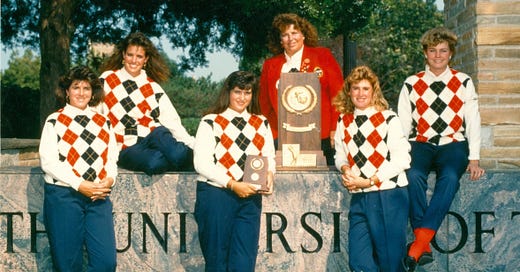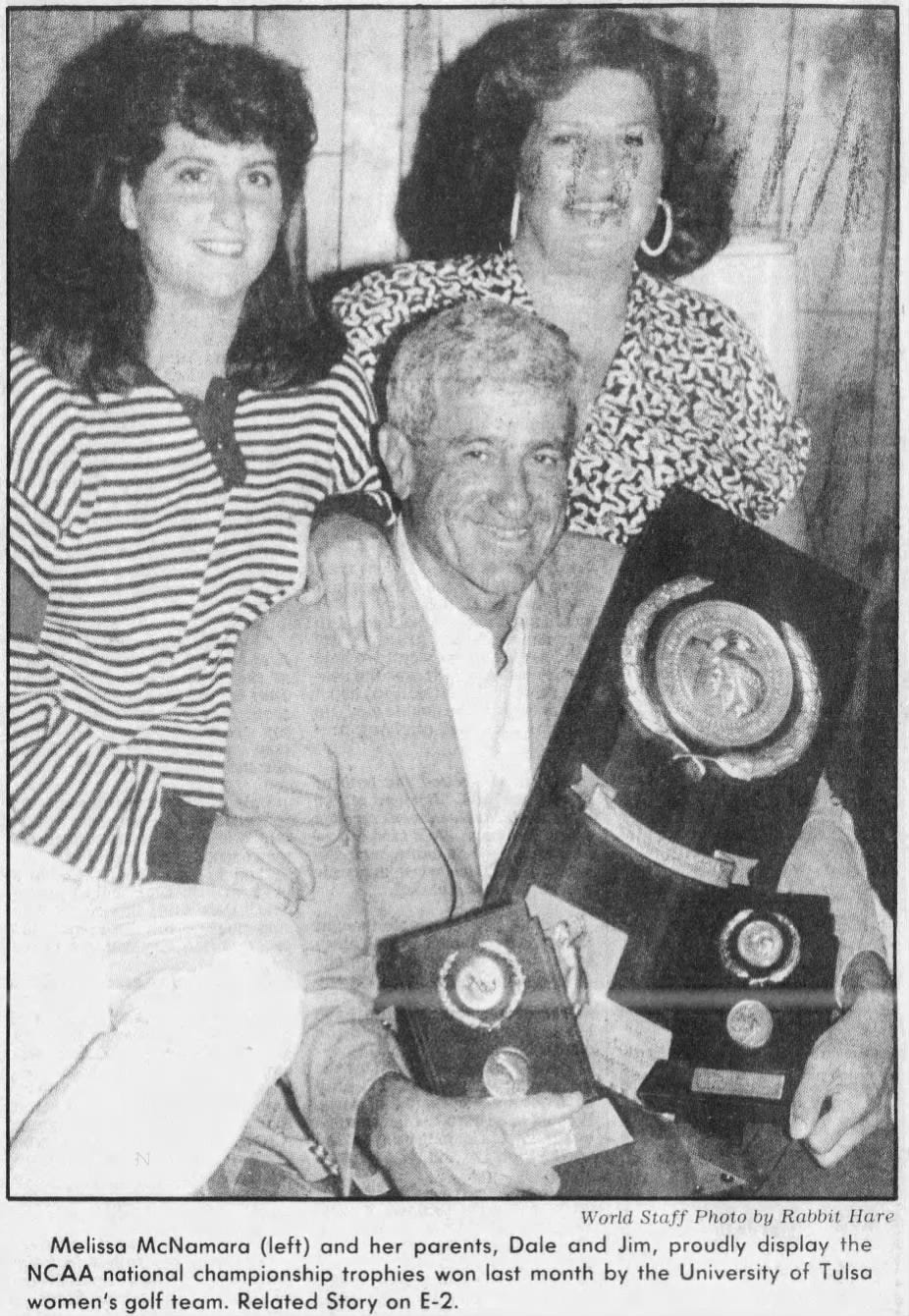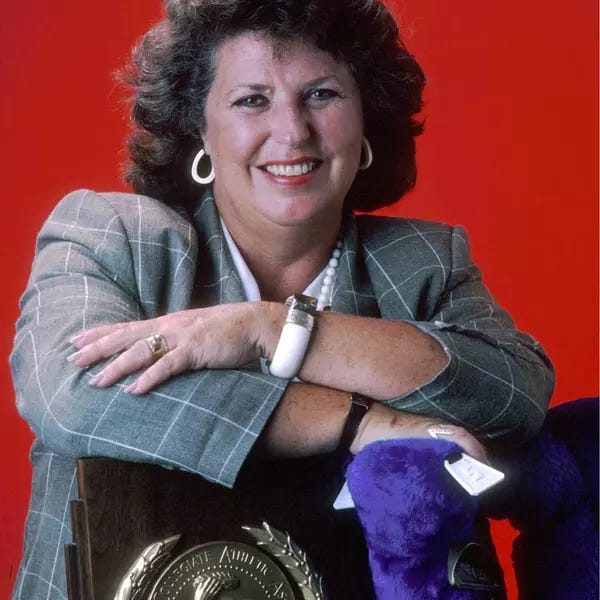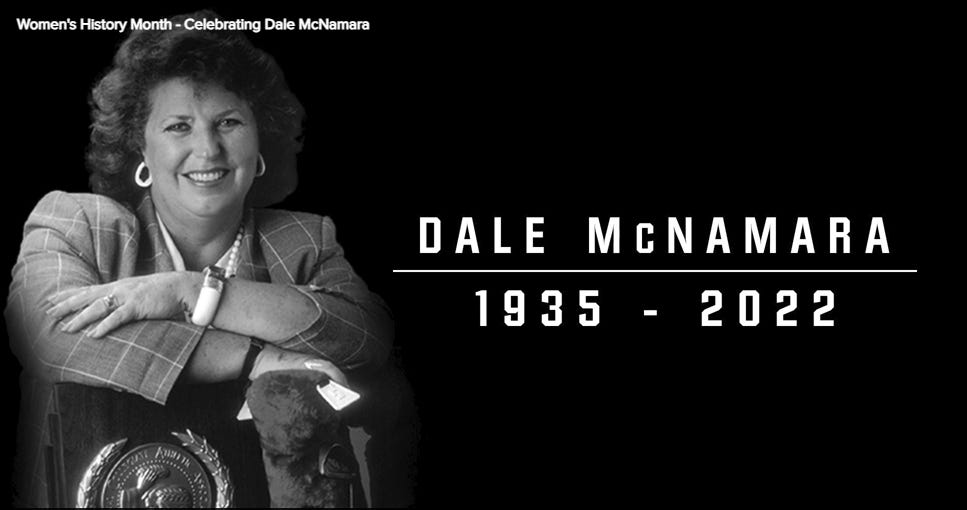This is part of a series on the Women’s Collegiate Championships
Coming off a disappointing 1986-87 season in which her Golden Hurricanes had missed the women’s golf championship tournament for the first time, Coach Dale McNamara vowed that she would show doubters that the University of Tulsa, the number 2 ranked team in the country, was still very much in contention to win titles. Not only was she right about her team, Coach McNamara lived out the dream scenario with her daughter, Melissa, also winning an individual title in her final collegiate tournament. It was a highlight achievement in a hall of fame career, but one that was stolen nearly five years later due to unethical conduct in a completely different sport.
*NOTE: underlined text provides a link to references or sites with more information
THE TOURNAMENT [May 25-28, 1988]
The 7th NCAA Women’s Golf Championship (and 45th championship overall) was hosted by New Mexico State at the university golf course in Las Cruces, New Mexico. A whole week of festivities was planned, tying the golf tournament to the university’s 100th anniversary. Several of the top teams in the country had put in for hosting duties for the 1988 championship, but New Mexico State’s Coach Paul Brilliant wanted it “real bad” and submitted an impressive bid proposal that included a videotape of the course shot from a hot air balloon. The last time NMSU had hosted the tournament was the last pre-AIAW championship in 1972, won by Ann Laughlin and the Miami (FL) team.
INDIVIDUAL RESULTS
Newspaper accounts of this championship made a point of highlighting the fact that nearly a quarter of the field was comprised of international players. In fact, 11 of the 14 teams had at least one player who hailed from countries such as American Samoa, Austria, Brazil, Canada, France, Japan, Spain, The Netherlands, and even “West Germany”.
One of the top competitors was freshman Longhorn sensation Michiko Hattori, one of the most decorated amateur players in the country that had made her way from Japan to Austin, TX to play for legendary Coach Pat Weis at the University of Texas based on a recommendation from Tom Kite to her coach in Japan, Tai Kawata. Hattori ultimately fell short of her goal in winning the NCAA championship despite two brilliant rounds in the 60s, but confessed to reporters at the end of tournament that she was just tired. Indeed, Hattori had been bombarded by excitement - not often seen in the college golf world - thanks to her amateur wins including three Japan Women’s Amateur titles (first when she was only 14 in 1984), US Women’s Am in 1985 (first Japanese-born player to win), and soon the Canadian Women’s Am in 1988. Coming into the NCAA tournament, Hattori had accumulated 5 collegiate wins and was ranked 2nd in the nation behind Tracy Kerdyk [Miami (FL)]. Kerdyk would go on to win Player of the Year honors from the Women’s Golf Coaches Association (WGCA), but the award was Hattori’s in 1989.
Not listed among the favorites was Melissa McNamara, Tulsa senior and coach’s daughter, who had found decent success in college but had yet to crack the top20 in her three NCAA appearances (T30, T45, and T45). Another player that wasn’t hyped as a pre-tournament favorite was Oklahoma State junior Eva Dahllof, but after a tournament and NCAA record -6 (68) in the first round (matched by Hattori in the 4th round), she certainly had everyone’s attention. She retained the lead after a second round even par 74, one stroke ahead of home-town hero Jacque Vigil [New Mexico State]. The third round is when McNamara made her move, gaining several strokes on the leaders with a 3-under 71 while most others were around par.
Coming into the final round, Dahllof still held the medalist position (216/-6) - which she shared with Denise Philbrick of the defending-champ San Jose State squad - and Vigil was still only one stroke behind (217/-5) along with McNamara. While the those other three players in contention shot mid-to-high 70s on the last day, McNamara was cruising around the course. She got an inkling that she was still near the top when reporters started showing up around the 16th hole and those suspicions were confirmed after sinking her final putt on the 18th and being immediately mobbed by teammates shouting “You won, you won!” The win was especially sweet for McNamara after the experience of playing as a lone individual the previous year. It was truly a storybook ending to her collegiate career.
After her Hall of Fame career at Tulsa, Melissa McNamara played over a decade on the LPGA Tour before returning to her alma mater to succeed her mom as the women’s golf coach. Not only did McNamara eventually get inducted into the WGCA Hall of Fame as a player in 1997, she also joined her mom (1988) in being inducted as a coach (Arizona State) in 2015. This is a fitting accomplishment considering they are the only mother-daughter combo (possibly the only parent-child combo for that matter) to win the individual and team title in the same year in college golf history.

TEAM RESULTS
One of the exciting new innovations in women’s college golf was the use of computer polls which were generated using a team’s/individual’s score relative to par. Coming into the 1988 NCAA tournament, Arizona State was the prevailing favorite - averaging 1.7 strokes under par as a team - followed closely by Tulsa (-0.7) and Texas (+0.2). Even as one of the top favorites, Tulsa had a large chip on their shoulder coming off an incredibly disappointing 1986-87 season where they had failed to make the championship tournament for the first time. Other contenders included defending champs San Jose State, Florida (who had won the two championship titles before that), Georgia, and even home town New Mexico State who were on a dream Cinderella run.
Weather was an issue early, causing a fairly significant pause in play during the first round, but otherwise was a non-factor during the tournament. Benefiting from getting their round in before the weather delay, Oklahoma State took the early lead by parlaying Dahllof’s 18 hole individual record into a course team record 291 (-7). They remained in the lead through 36 holes, but the cushion had shrunk to just 2 strokes over host New Mexico State and 4 strokes over Tulsa. Both Oklahoma State and New Mexico State blew up in the third round, and were passed by several teams shooting sub-300 scores. At that point Tulsa was now in the lead by 3 strokes over Arizona State, 4 over Georgia, and 6 over defending champs San Jose State.
Tulsa came out strong in the final round and never let up. Their team 286 (-10) broke the record OSU set in the first round, and put them well clear of the rest of the field. How good were the Golden Hurricanes in that final round? Their drop score was a one-under par 73! After McNamara sank her final (individual title winning) putt, the group of Margaret Kelt, Blue Kinnander, Kelly Robbins, and Caryn Louw mobbed their teammate and coach who were already in a teary-eyed embrace. Tulsa’s final 72 hole score of 1175 (-9) broke Florida’s record (1180) set in 1986 when they won their second consecutive championship.
In recognition of another historic accomplishment, the team as a whole was inducted in to the Tulsa Athletic Hall of Fame.
A TITLE STOLEN, NOT LOST
Imagine, if you will, that you have achieved your ultimate goal as a collegiate athlete, winning an individual title in your favorite sport, and in the process being the leader that secures the team title as well. Even though you have recently graduated, the joy and sense of accomplishment that comes with this success lingers as you move into your professional career. Four years later - your crowning moment now practically as far in the past as the amount of time you spent in college chasing it - you and your teammates reconnect and hurriedly plan a long overdue meetup. Instead of joyous laughter reminiscing your shared glory, there are only tears and that inescapable sinking feeling as you collectively try to figure out what the hell just happened and how can they take this away from us?!
THE “CRIME”
The NCAA investigation into possible athletic misconduct at the University of Tulsa began in 1991 after receiving an anonymous letter alleging that the Track and Field team failed to meet their minimum team requirements (14 men and 14 women) during the previous season. During the course of this investigation, the NCAA found that the issue actually went back to the 1987-88 season, and that there had been multiple occasions in the seasons since where the coach had submitted false rosters to make the appearance of carrying full teams. Because the Track and Field teams were not in compliance, the University had failed to sponsor the minimum 7 men’s (only had 6) and 7 women’s (only had 5) teams required for NCAA membership.
AN UNFIT PUNISHMENT
This essentially meant that the university was retroactively found to not have met the minimum requirements for membership, thus they could not have been considered a member in good standing during competitions during the 1987-88, 1988-89, and 1989-90 seasons. Among the many expected punishments against the coach(es) and administrators found to be responsible for this misconduct, the NCAA ruled that:
SECTION E. The institution shall vacate team awards in all NCAA championship competition for all sports during the 1987-88, 1988-89 and 1989-90 academic years. This penalty is applied to all teams because the [Page 7] institution did not qualify for Division I membership during these years. This penalty does not necessitate vacating any individual awards.
That’s right...just like that, you and your teammates in an unrelated sport had your team title vacated four years later. Given the circumstance, getting to keep the individual title you earned is a nice but somewhat hollow consolation.
Coach Mike McGraw interviewed Melissa (McNamara) Luellen - who now coaches at Auburn - in 2024 for his podcast Better Than I Found It, and part of their conversation dove into this championship. This episode (like all of them) is well worth the listen:
COACHES CORNER: DALE McNAMARA
SUCCESS AS A PLAYER
Born Dale Fleming, the future Tulsa coach started out as a Tulsa player without the benefit of a team. Despite the fact that there was no women’s golf team when she attended in the 1950s, she still competed as an individual on multiple occasions and became the first woman in school history to earn an athletic letter. She was known throughout the Oklahoma junior golf circuit and then throughout the state when she won her third state amateur title in just four years (1956, 1957, 1959). She would go on to win four more titles, setting the record with her 7th Oklahoma (State) Amateur victory in 1975. She described that final win - achieved in front of crowd that included her husband Jim and daughters Cathy (13) and Melissa (9) - as “terribly important” and was quoted by the Tulsa World newspaper as saying:
“Since I was 16, I’ve wanted to have this record, to win more stat championships than any other woman in Oklahoma has ever won. Of course, winning my first was a big thrill, and there’s nothing to compart with winning your second, to show everybody that first title wasn’t an accident. But this one was terribly important. I wanted this one.”
She was inducted into the Oklahoma Golf Hall of Fame in 2006 as “Dale Fleming McNamara” and is rightly described as “a pioneer in women’s collegiate golf and one of the most successful coaches in the history of the game.”
SUCCESS AS A COACH
McNamara the player became Coach McNamara in 1974 when she volunteered for the position to start a women’s golf program at Tulsa. Well, more like “volun-told” as the university needed to start the program to comply with Title IX which had passed two years earlier. Without funding, a team, and hardly even a desk to call her own, there were practically no expectations and even less to suggest that she was on the verge of a Hall of Fame worthy career.
More than just coaching, McNamara quickly demonstrated her prowess as a recruiter, bringing in one of the country’s best recruits, Nancy Lopez, in just her second season. The team was quickly in contention at the AIAW championship, Lopez even winning medalist honors as a freshman in 1976. Just a few short years later, Tulsa earned its first AIAW title in 1980 thanks in part to two other sensational freshmen, Sharon Barrett and Kathy Baker. Two years later Baker led the charge during that historic double championship run in 1982, winning medalist honors in the first ever NCAA Women’s Golf Championship followed a month later by a top 10 performance at the last AIAW championship as Tulsa took both titles.
Shortly before that 1988 NCAA Championship, Coach McNamara was inducted in the WGCA Hall of Fame, making Tulsa’s return to the top of the podium extra sweet. The next couple of years were solid, but didn’t result in the finish at the NCAAs Coach McNamara had come to expect. Then came the probation years where, through no fault of her own, the Tulsa golf team was forced to miss NCAAs multiple times in the early 1990s. It could have ended there. Instead, Coach McNamara continued to lead the charge, winning dozens more regular season team tournaments, multiple Missouri Valley Conference titles, MVC and National Coach of the Year awards, and several top 10 finishes at NCAAs.
A LEGACY THAT LIVES ON
Coach Dale McNamara turned over the program reigns to Coach Melissa McNamara to begin the 2000-01 season. Over the course of her illustrious career, Dale McNamara coached nearly 30 First or Second Team All-Americans who helped accumulate over 80 tournament victories (currently fourth all time). Her legacy to the University of Tulsa and the college golf world at large went far beyond these impressive numbers.
A wonderful video made by Tulsa celebrating Coach Dale McNamara can be watched below, and says more than we ever could in the space available in this post. More can be read about her passing in 2022 - and more importantly the life she lived and people she inspired along the way - in this Golf Digest article as well as these memories Coach Luellen shared about her mother in 2018.
Thanks for reading!
Up Next:
In the next post for this series, we will cover the second Arizona State Sun Devil dynasty that spanned the 1990s and ushered in the age of Regionals.












